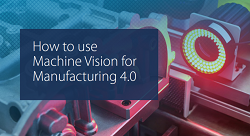Contributed by: Patrick Chabot - Manufacturing IT Manager
Are your machine vision needs on the production line better served with a smart camera, or a “dumb,” more basic one? One way to consider this question is through the lens (pun intended) of Industry 4.0 / Manufacturing 4.0.
The decision must be based on what you need to get from your data—not how the data is acquired. Before you make the investment (or waste an investment you already made), consider the factors that can dictate which option is better for a given situation.
Smart cameras vs. basic cameras for machine vision
A smart or embedded camera combines imaging and processing technologies into a single durable and compact form factor. Since it’s a self-contained unit, the enclosure has a smaller footprint than a PC-based system. It is also usually better sealed and resistant to contaminants. On the negative side, it historically has less processing horsepower onboard compared to a PC-based machine vision system.
PC-based machine vision systems typically use basic cameras that do nothing more than take images (hence the term “dumb”). The PC controller does all the heavy lifting, not the cameras. This continues to be the more powerful and flexible system, but smart camera makers are constantly pushing the envelope of the features and capabilities they can cram into that little unit. While each dumb camera is as small or even smaller than an equivalent smart camera, the PC controller itself means they have a larger installation footprint and usually require an enclosure to deal with environmental contaminants.
Do you need a smart camera for your machine vision checks?
If you employ machine vision only for basic compliance checking (for visual confirmation of part presence, orientation, placement, count, etc.), then the data considerations are not a factor.
But if your quality assurance processes require a deeper probe inside the black box of the vision system, then data of course conquers all because that is where the answers you’re looking for lie.
In this scenario, you want to aggregate the unique scalar measurements that can be taken from the camera image. Capturing and trending that data across every part inspected can reveal any variance that indicates a flaw or defect. It could be in the dispense of sealant, the machining of a surface, the alignment of two parts being pressed together and so on.
This vision data can then be collected into a central database where it can be correlated with other production data to quickly trace root cause when quality issues arise and to conduct “what if?” analysis in a virtual testbed.
Both types of camera systems are capable of outputting data (though some smart cameras might be limited in what they can output efficiently between cycles). Both may have the same resolution and image quality.
Should you invest in smart cameras for your manufacturing line?
From an Industry 4.0 / Manufacturing 4.0 perspective, the choice then really boils down to simple economics given your usage scenario and the conditions on the factory floor that may impact camera performance. The best solution may be one that combines the use of both types of systems.
As far as pricing, a single smart camera is usually cheaper to purchase than a PC-based vision system with a single camera attached to it. That said, it is very common to have a vision system that takes images from multiple angles to evaluate a single part or that takes images of multiple parts concurrently using more than one camera. In these cases, a smart camera’s price advantage quickly fades. For example, a setup using eight smart cameras might easily cost twice as much as a PC system with eight dumb cameras.
Ultimately, data is the key, not the hardware that generates it.
To learn more about Sciemetric’s data solution for machine vision applications, click here.
Free E-book: How to use Machine Vision for Manufacturing 4.0
Vision systems are valuable tools for quality inspection, but how are you using the massive number of images and amount of data they produce? This e-book explains why you should integrate machine vision output with the rest of your process data for a complete picture of production health.


